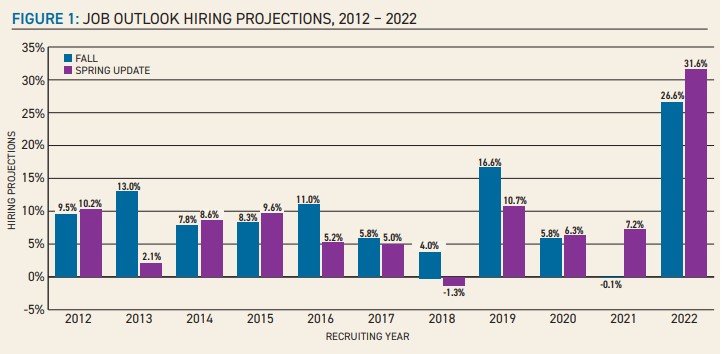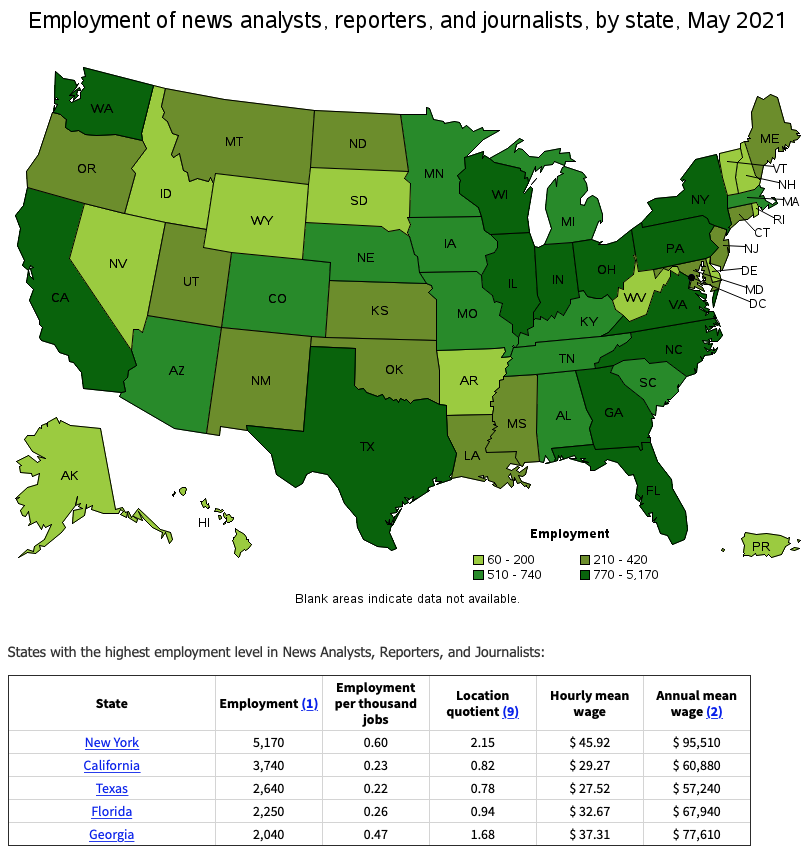The specter of COVID-19 no longer looms over the job market as it did in 2020, according to experts. Now that hiring is rebounding, and inflation is on the rise, journalism graduates need to hold on to a realistic mindset while looking for full-time jobs.
The realism comes in handy for journalism graduates who, according to a 2022 survey completed by Real Estate Witch, expect to earn as much as $107,040 or 139% more than the median journalist’s starting salary, which is $44,800. That starting salary coincides with Reuters Research and comes close to the U.S. Bureau of Labor Statistics’ May 2021 median pay of $48,730 or $23.26 per hour for journalists.
Career placement experts recommend graduates prepare for the job search by networking, putting a plan in place, and building a narrative of themselves for employers to hear.
“You have to do the work to get the work,” said Sharon Irwin-Foulon, executive director of Arizona State University’s W.P. Carey Career Management and Employer Engagement. “It’s a competitive world out there. When students flounder, they haven’t thought out the advice and resources they’re privileged to have.”
Unrealistic expectations aside, two organizations are reporting that a hiring surge has taken place in the United States: The U.S. Bureau of Labor Statistics (BLS) and the National Association of Colleges and Employers (NACE). NACE is a professional organization that connects college career service professionals and recruiters. According to NACE, employers were saying in 2020 that they would only increase hiring by 5.8% in the fall and 6.3% in the spring semesters. Today, employers are calling for hiring surges of 31.6% this spring and 26.6% in the fall 2022 semester.

BLS saw overall increases in the number of college graduates being employed. Between January and October 2021, 1.3 million people, between the age of 20-29, earned bachelor’s degrees in the United States, and 74.8% of those new graduates were employed by October 2021. BLS also predicted that jobs for news analysts, reporters, and journalists will grow at about 6% between 2020 and 2030. That percentage represents a growth rate as fast as the average for all jobs according to BLS, which is 8%.
States with the highest employment levels for journalists are New York, California, Texas, Florida, and Georgia, according to BLS. The average annual and hourly wage in those states ranges from $37.31/ hour, or $77,610 per year, to $45.92 /hour, or $95,510 a year. The District of Columbia, New York, Connecticut, Georgia, and New Jersey represent the top paying states for journalists. New Jersey journalists’ jobs pay an average of $36.59/hour or $76,110 per year. District of Columbia journalist jobs pay an average of $53.54/hour, or $111,360 a year.


Irwin-Foulon says she’s heard a common complaint from employers about today’s grads.
“They’ve not done the work on how to show up competitive,” Irwin-Foulon said. “(An employer) will want to know you’re resourceful and you can optimize whatever is given to you.”
ASU’s Walter Cronkite School of Journalism graduate Sinobia Aiden set a goal for herself to be employed before graduation. She said many of her friends had jobs months ago.
“It’s really easy to compare your journey to others,” Aiden said. “Everybody’s on their own journey. Instead, celebrate yourself. Celebrate all you’ve accomplished. Now’s a really good time to lean on each other. Look over resumes, cover letters. Practice interviews.”
When asked how many interviews she’d been on before graduation, she laughed and offered additional advice: “There are so many times you’re not going to hear back.”
Aiden reached her goal. She applied for a job at Politico as a digital producer because it had everything she wanted. She was offered a job before graduation and started on May 17.
National trends on the job market are showing that more women are being hired than men, 80% to 68%, according to BLS. Also, NACE has reported that part of the reason for the surge in hiring is because increases are occurring “across a variety of industries” NACE Executive Director Shawn VanDerziel said in a news release.
Other hiring trends in the field of journalism involve diversity progress. According to The Journalism, Media and Technology Trends and Predictions study by Nic Newman through the Reuters Institute and the University of Oxford, reports that more publishers are recognizing the damage a lack of diversity has caused in public trust. The lack of diversity won’t be solved in 2022, the report added. But employees like Sally Buzbee, the first female executive editor of the Washington Post, was hired with a directive to “prioritise diversity and inclusions in our news coverage as well as our hiring and promotion.”
Leading up to 2020, newsroom employment had been on the decline, according to the Pew Research Center. In 2008, the center reports, there were 114,000 total newsroom jobs. In 2020 that number decreased to about 85,000.
Other trends rest with students’ expectations of the job market. Irwin-Foulon said some Generation Zers think “They’re going to be discovered.” She attributes that mentality to the digital life and stories of people who got discovered.
“They’re around the myths,” she said. “They’re focusing on the exceptions – not the masses.”
Another national trend new graduates have to watch out for is post-graduation stress or depression. Neither is a formal diagnosis. However, students should be mindful of their mental health during the transition from higher education to the workforce.
To ensure more is done for student mental health at the federal level, NACE is urging Congress to get more involved with prioritizing mental health legislation. In a letter sent to members of Congress in April, the organization cites statistics from American College Health Association. From 2000 to 2019, rates of students reporting being diagnosed with depression have increased by almost 250%, according to the letter.










